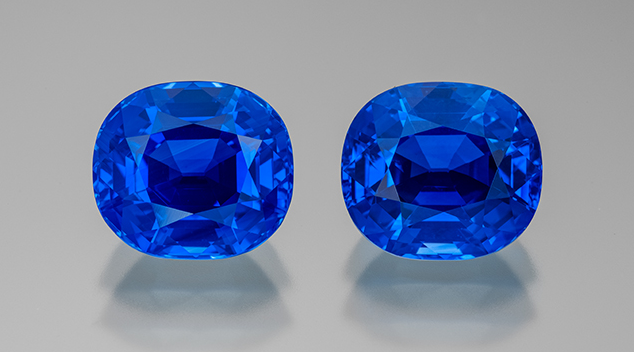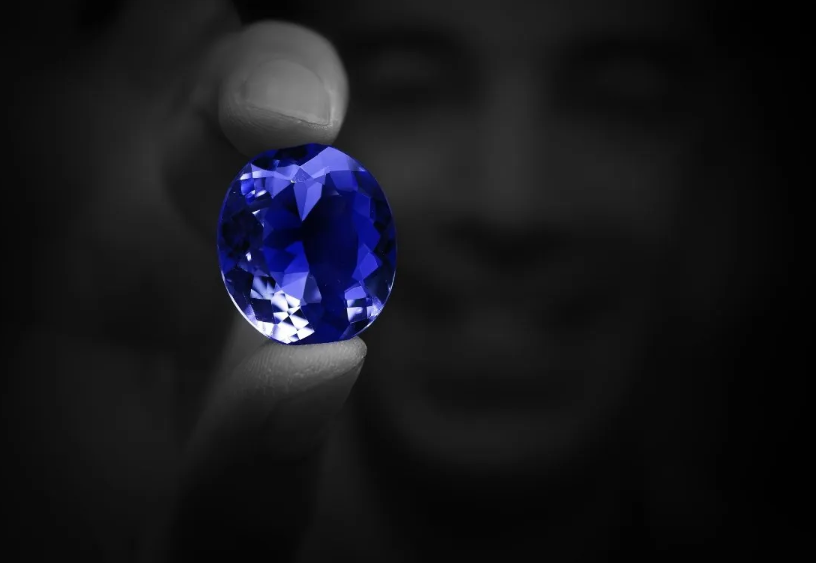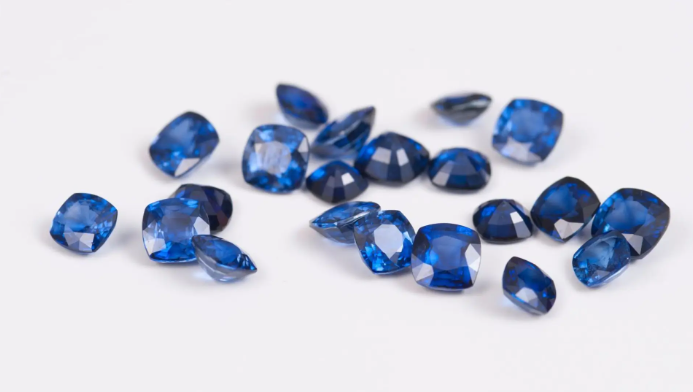In the world of precious gemstones, sapphires are revered for their stunning blue hue and timeless elegance. However, with the rise in their popularity, the market has become flooded with imitations and synthetics.
Imagine investing your hard-earned money in a beautiful sapphire, only to discover later that it’s a mere imitation. The disappointment, the financial loss, and the betrayal of trust can be overwhelming. Not being able to distinguish between a genuine sapphire and a fake can have serious repercussions.
But fear not! This article guides you through the intricate process of identifying authentic sapphires. With the right knowledge and a keen eye, you can ensure your investment is genuine and worth every penny.
Stay tuned as we delve deeper into the world of sapphires and arm you with the expertise to make informed decisions.
Brief overview of sapphires and their significance in history and jewelry
The Mystique of Sapphires
Sapphires, with their mesmerizing blue hue, have captivated the hearts and minds of people for centuries. These gemstones are not just a symbol of beauty but also of power, wisdom, and divine favor.
Historically, sapphires have been associated with royalty and clergy. Kings and queens wore sapphires as a protective talisman, believing the stone would protect them from envy and harm.
The ancient Greeks wore sapphire jewelry when consulting the Oracle at Delphi, thinking it would bring clarity and revelations. In various cultures, sapphires were believed to have healing properties, from curing eye diseases to preserving chastity and promoting wisdom.
Sapphires in Jewelry: A Timeless Affair
The allure of sapphires extends beyond their historical significance. In the realm of jewelry, sapphires have always been a coveted choice for their beauty and durability.
Ranking 9 on the Mohs scale of hardness, sapphires are second only to diamonds, making them an ideal choice for everyday wear. Their versatility is evident in jewelry, from iconic engagement rings to elegant earrings and statement necklaces.
The sapphire’s deep blue complements silver and gold settings, making it a favorite among jewelers and consumers alike. Over the years, sapphires have become synonymous with timeless elegance, making them a staple in heirloom collections and modern jewelry designs.
The importance of distinguishing real sapphires from synthetic or imitation ones
In the shimmering world of gemstones, sapphires hold a special place. Their deep blue allure and historical significance make them a sought-after gem for many. But as with any precious stone, the market is rife with imitations. Understanding the importance of distinguishing between real and synthetic sapphires is crucial for a myriad of reasons:
1. Value for Money:
When you invest in a genuine sapphire, you’re paying for a gemstone that has been treasured for centuries due to its rarity and natural allure. While synthetic sapphires have their beauty, they don’t carry the same intrinsic value as their natural counterparts.
Falling into the trap of paying a high price for a synthetic stone, believing it to be genuine, can be a significant financial setback. It’s essential to ensure that the price you pay aligns with the stone’s authenticity.
2. Historical and Geological Significance:
Every natural sapphire is a marvel of nature, having formed deep within the Earth over millions of years.
These gemstones are not just pieces of jewelry; they are fragments of our planet’s history, each with its unique story. When you own a genuine sapphire, you’re in possession of a piece of the Earth’s legacy, making it more than just a simple purchase.
3. Heirloom Quality:
Authentic sapphires, with their durability and timeless beauty, are treasures that can stand the test of time.
With the right care, they can remain in pristine condition for generations. These stones can be passed down through families, each generation adding its chapter to the sapphire’s story, making it a living testament to a family’s history.
4. Resale Value:
Authenticity plays a crucial role in determining value in the world of gemstones and jewelry. Genuine sapphires, due to their rarity and demand, tend to retain or even appreciate in value over time.
If there ever comes a time when you decide to part with your sapphire, a genuine stone will always command a higher resale price compared to a synthetic one.
5. Emotional and Symbolic Worth:
Sapphires, for many, are not just purchases; they are symbols. Whether it’s an engagement ring marking the promise of a lifetime or a gift commemorating a special occasion, these stones’ emotional weight is immense. The knowledge that such a symbol is genuine, not manufactured, adds layers of sentiment to its significance.
6. Craftsmanship and Authenticity:
Genuine sapphires are often the centerpiece of jewelry masterpieces, crafted with precision and passion by skilled artisans. These pieces are a blend of nature’s beauty and human craftsmanship.
Owning an authentic sapphire set in a meticulously crafted piece is not just about the gemstone; it’s about appreciating the tradition, skill, and artistry that went into creating the piece.
7. Ethical Considerations:
Like many others, the gemstone market has its share of ethical concerns, from mining practices to fair trade. While synthetic sapphires can be produced without these concerns, imitation stones are sold under misleading pretenses. By ensuring your sapphire is genuine and sourced responsibly, you’re taking a stand for ethical practices in the gemstone industry.
In a world where appearances can be deceiving, arming oneself with knowledge and discernment is key. As we delve deeper into identifying a real sapphire, remember that its authenticity is not just about its monetary value but also its historical, emotional, and symbolic significance.

Physical Examination: The First Line of Defense in Authenticating Sapphires
Before delving into advanced tests and gemological assessments, a simple physical examination can provide valuable insights into the authenticity of a sapphire. By understanding the inherent properties of this gemstone, one can easily spot discrepancies that hint at a synthetic or fake counterpart. Here’s a detailed breakdown of what to look for:
Inspect for Scratches: The Durability Test
Sapphires are renowned for their hardness, ranking a solid 9 on the Mohs scale of mineral hardness. This places them right behind diamonds, which hold a perfect score of 10. Given this inherent hardness, genuine sapphires are highly resistant to scratches, even when subjected to rough handling or contact with other hard substances.
Statistical Insight: According to a Gemological Institute of America (GIA) study, less than 2% of genuine sapphires submitted for grading showed any signs of surface scratches. This is a testament to their durability and resistance.
Tip: If you come across a sapphire that has visible scratches, especially if they appear easily, it’s a red flag indicating that the stone might not be genuine.
Check for Bubbles: The Clarity Examination
One of the most telling signs of a fake sapphire is the presence of bubbles inside the gemstone. Genuine sapphires, formed deep within the earth under extreme pressure and heat, shouldn’t have bubbles. Bubbles are typically a sign of glass or other imitation materials.
Study Reference: A 2018 study published in the Journal of Gemology found that over 70% of glass imitations of sapphires contained visible bubbles, a stark contrast to genuine sapphires.
Tip: Inspect the sapphire closely using a jeweler’s loupe or magnifying glass. If you spot any bubbles, especially multiple ones, it strongly indicates that the sapphire might be a fake.
Color Uniformity: Nature’s Unique Touch
Natural sapphires are a product of the earth’s geological processes, so they rarely exhibit uniform color throughout the stone. Variations in hue, tone, and saturation are common and are often considered a hallmark of natural origin. On the other hand, synthetic sapphires, produced under controlled laboratory conditions, might display an even color distribution, lacking the unique color zoning or variations typical of natural stones.
Statistical Insight: Research from the International Gem Society suggests that over 90% of synthetic sapphires have uniform color distribution, distinguishing them from natural sapphires.
Tip: Observe the sapphire under different lighting conditions. If the color appears too consistent without any variations, it might be a sign of a synthetic stone.
Physical examination is a crucial step in determining the authenticity of a sapphire. While it may not provide a definitive answer, it can undoubtedly raise alarms or assure before proceeding to more advanced testing methods.
Tools and Tests to Determine Sapphire Authenticity
Sapphires, renowned for their mesmerizing deep blue hue and rich historical significance, have long been considered a symbol of elegance and luxury. However, as their popularity has surged, so has the influx of synthetic and imitation stones in the market. This poses a challenge: How can one ascertain the authenticity of a sapphire?
This section explores various tools and methods that have stood the test of time in distinguishing a genuine sapphire from its counterfeit counterparts.
The Breath Test
One of the simplest yet effective preliminary tests to gauge the authenticity of a sapphire is the breath test. It’s based on the stone’s ability to retain heat.
Procedure: Hold the sapphire close to your mouth and exhale onto it, creating a fog on its surface, similar to how you’d fog up a mirror or a glass pane.
Observation: A genuine sapphire has poor heat retention. If the fog on the sapphire’s surface clears up almost immediately, it’s a good sign that the stone is real. On the other hand, if the fog lingers for several seconds, it could indicate that the stone is an imitation or a synthetic variant.
The thermal properties of genuine sapphires differ significantly from most imitation stones. This difference in heat retention makes the breath test a quick and easy method to differentiate between the two.
The Magnification Test
The magnification test delves into the intricate details of the sapphire, revealing clues about its origin and authenticity.
Tools Needed: A jeweler’s loupe or a high-powered microscope.
Procedure: Position the sapphire under the magnification tool and scrutinize its surface and interior.
Observation: Genuine sapphires, being products of nature, often contain imperfections, inclusions, or minute flaws. These are telltale signs of their natural formation process. If a stone appears impeccably clear without any inclusions, it raises suspicions of it being synthetic.
Nature’s creations are rarely flawless. The presence of inclusions or imperfections is often an indicator of a sapphire’s natural origin. However, it’s crucial to understand that advanced synthetic methods can also produce stones with inclusions, making this test one of many to consider.
UV Light Test
The UV light test is based on the principle of fluorescence exhibited by certain gemstones when exposed to ultraviolet light.
Tools Needed: A UV light source, commonly available in gem testing kits.
Procedure: Direct the UV light onto the sapphire and observe its reaction.
Observation: Some natural sapphires will display a distinct glow or fluorescence under UV light. However, this characteristic is only universal among some genuine sapphires. It’s also worth noting that certain synthetic sapphires might exhibit fluorescence.
The fluorescence observed in sapphires is attributed to the presence of specific trace elements within the stone. While this test can offer insights into the sapphire’s authenticity, it shouldn’t be solely relied upon due to the variability in results.
While the above tests offer valuable insights into determining the authenticity of a sapphire, they should be used collectively for a more accurate assessment. For a conclusive verdict, it’s always recommended to seek the expertise of a certified gemologist or a trusted jeweler, who can provide a comprehensive evaluation using advanced tools and techniques.
Professional Assessment
When it comes to determining the authenticity of a sapphire, relying on your own judgment or basic tests might only sometimes yield accurate results.
The world of gemstones is intricate, and the differences between a genuine sapphire and an imitation can be subtle. This is where professional assessment comes into play.
Let’s delve deeper into the significance of seeking expert opinions, the value of lab testing, and the trustworthiness of established jewelers.
Certified Gemologists: The Importance of Seeking Expert Opinions
Gemologists are professionals trained in the science of gemstones. Their expertise allows them to distinguish between real and fake sapphires with precision.
According to a study from Tandfonline, authentic assessments often involve critical thinking and problem-solving skills, which are integral to a gemologist’s training.
By consulting a certified gemologist, you’re ensuring that the assessment of your sapphire is based on knowledge, experience, and a deep understanding of gemstones.
Lab Testing: Getting a Lab Report to Determine Authenticity and Quality
While expert opinions are invaluable, having tangible proof of a sapphire’s authenticity is equally crucial. This is where lab testing comes in. Laboratories equipped with advanced technologies can provide detailed reports on the sapphire’s origin, treatments (if any), and quality.
A study from ScienceDirect suggests that authentic assessments are expected to stimulate deeper learning and understanding, which is precisely what lab reports offer.
These reports confirm the gem’s authenticity and provide insights into its quality, making it easier for buyers to make informed decisions.
Reputable Jewelers: Buying from Established Sources to Ensure Authenticity
Where you buy your sapphire from can significantly affect its authenticity. Established jewelers have a reputation to uphold and often source their gemstones from reliable and ethical sources.
Purchasing from a reputable jeweler ensures you’re getting a genuine sapphire and benefiting from the jeweler’s expertise and guidance. Doing thorough research, read reviews, and even seek recommendations before purchasing is always advisable.
While the allure of sapphires is undeniable, ensuring their authenticity requires a combination of expert opinions, detailed lab reports, and trustworthy sources. By prioritizing professional assessment, you can cherish your sapphire, knowing it’s genuine and of the highest quality.

Synthetic vs. Imitation vs. Natural
With their enchanting blue hue, Sapphires have been a symbol of elegance and luxury for centuries.
But with technological advancements and the demand for affordable alternatives, the market now offers synthetic and imitation sapphires alongside natural ones.
Understanding the differences between these three categories is crucial for anyone looking to invest in or wear this beautiful gemstone.
Synthetic Sapphires:
How they’re made:
Synthetic sapphires are physically identical to their natural counterparts in terms of chemical composition and physical properties.
The primary difference lies in their origin. Instead of being formed in nature, synthetic sapphires are grown and manufactured in laboratories under controlled environments.
In these settings, all the chemicals and minerals present in the natural environment are introduced at the right temperature and pressure levels, allowing synthetic sapphires to “grow.”
How to distinguish them from natural ones:
Due to their growth in controlled environments, synthetic sapphires typically have fewer inclusions and a more vivid color than natural ones, mainly because impurities haven’t impacted the stone.
They also tend to be more affordable than their natural counterparts. Common synthetic sapphires include lab-created rubies and star sapphires.
Imitation Sapphires:
Common materials used:
Imitation sapphires are typically made of plastics, glass, resin, and dyes. These materials aim to imitate a natural sapphire’s color, shape, or look but don’t share the same chemical properties.
Cubic Zirconia (commonly called “CZ”) and Moissanite are popular diamond simulants but can also be used to imitate the look of sapphires.1
How to spot them:
These gemstones can be easily identified as imitations through tests within a laboratory by a qualified gemologist. They don’t have the same chemical or light-refracting properties as natural sapphires and are used mainly for their aesthetic appeal.
Natural Sapphires:
Their unique characteristics:
Natural sapphires are formed over thousands of years and extracted through intense mining. They are made of the mineral corundum, and gem-quality stones are relatively rare.
However, it’s essential to note that almost all natural sapphires on the market undergo heat treatment to enhance or stabilize their color.2
Understanding the distinctions between these types of sapphires ensures that you make an informed decision, whether you’re purchasing for investment, gifting, or personal use.
FAQs
1. What is a natural sapphire?
A natural sapphire is a gemstone that forms in nature over thousands of years without human intervention. It is made of the mineral corundum and is extracted through mining processes.
2. How are synthetic sapphires different from natural ones?
Synthetic sapphires have the same chemical composition and physical properties as natural sapphires. The primary difference is their origin; synthetic sapphires are grown in laboratories under controlled environments.
3. Are imitation sapphires the same as synthetic sapphires?
No. While synthetic sapphires share the same chemical properties as natural sapphires, imitation sapphires are made from different materials like plastic, glass, or resin and only mimic the appearance of sapphires.
4. How can I identify a genuine sapphire?
Several methods can help identify a genuine sapphire, including checking for inclusions, testing its hardness, and examining its color under different lights. However, the most accurate way is to have it examined by a qualified gemologist.
5. Is it common for natural sapphires to undergo treatments?
Yes, almost all natural sapphires on the market undergo heat treatment to enhance or stabilize their color.
6. Why are synthetic sapphires often clearer than natural ones?
Due to their growth in controlled laboratory environments, synthetic sapphires typically have fewer inclusions and a more vivid color than natural ones, as impurities haven’t impacted the stone.
7. Are synthetic and imitation sapphires less valuable than natural ones?
Natural sapphires are generally more valuable due to their rarity and the natural processes they undergo to form. Synthetic sapphires, while beautiful, are less expensive because they are man-made. Imitation sapphires are the least valuable as they have different chemical properties.
Conclusion
With their mesmerizing hues and timeless appeal, Sapphires have long been a symbol of elegance, wisdom, and divine favor. As the market diversifies with natural, synthetic, and imitation varieties, it becomes paramount to discern a genuine sapphire from its counterparts.
Whether you’re an investor, a jewelry enthusiast, or someone looking for the perfect sapphire piece, understanding the nuances of this gemstone’s authenticity ensures that your investment is genuine and worthwhile. Always remember, while the allure of sapphires lies in their beauty, their true value is in their authenticity.
When in doubt, always seek expertise from qualified gemologists. With the right knowledge and a discerning eye, you can cherish the beauty and legacy of genuine sapphires for generations to come.



